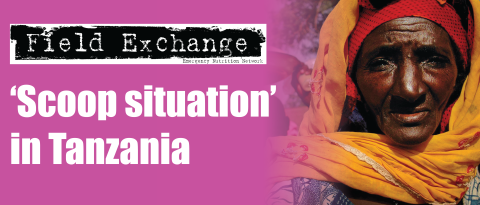Market analysis and humanitarian action in Niger
Summary of published research1

Women and children, in the village of Barmou, gather and wait to receive WFP distributed food
In April 2005, a typical household in Niger depended on market purchases for 90% of its food. The large majority of Sahelian households are not self-sufficient in staple foods. This market dependence increases in years of poor agricultural production. Food security analysis in the Sahel has for some time focused on the assessment of agricultural production. A recent article in Humanitarian Exchange argues that it is now time to devote more resources to analysing how markets contribute to the distribution and pricing of food and that market analysis is important for food security assessment. There are three main reasons for this. First, markets have the capacity to ameliorate the negative impacts of shocks. Second, market analysis contributes to food security monitoring and third, market analysis informs the debate over cash versus food assistance.
The hike in food prices in Niger followed steep price rises in Nigeria, caused by lower agricultural production and buoyant demand. This stemmed from high consumer purchasing power and demand from the poultry and food processing sectors. Higher prices in Nigeria caused a drastic drop in exports to Niger. Meanwhile cereal flows reversed with Niger now supplying Nigeria. This trade-driven supply squeeze was compounded by lower domestic crop production because of locust attacks and some dry spells.
During 2004-5, SIMA (the national system for agricultural market information in Niger) and FEWS NET2 reported relatively high price levels, although this alert was not well received by humanitarian actors and donors. The reasons advanced to explain the price increases were neither complete nor convincing. This was mainly because of a lack of shared knowledge of cereal markets and trade and the absence of reliable statistics on imports and agricultural production in Nigeria. In addition, humanitarian actors did not understand just how dependent households in Niger were on food market purchases, how households were linked to markets and how these relations had evolved. Lastly, there was no agreed alert threshold for price increases amongst humanitarian actors.
The widespread publicity given to food prices and markets during the Niger crisis encouraged greater analysis of cross-border trade and markets. FEWS NET, SIMA and the Permanent Interstate Committee for Drought Control in the Sahel (CILSS) began conducting missions to markets in northern Nigeria that helped provide an explanation of the 2005 price hike. The following lessons were learnt.
- A sub-regional or regional approach, covering all the key trade linked zones in West Africa, is preferable to a purely national approach.
- Assessments should devote more attention to demand factors at the micro level, in addition to analysing the various sources of food supply, prices, markets and trade structures. Market monitoring should be conducted on the basis of an agreed understanding of the market's structure, conduct and performance. The analysis should cover flow information, as well as prices. Partnerships for market assesments should be broadened to capture the multidimensional character of markets and to agree on conclusions and recommendations.
At the end of 2005, FEWS NET and the World Food Programme (WFP) launched a study to identify knowledge gaps regarding links between markets and food security in West Africa. The study also formulated recommendations to reinforce market analysis of food security assessments. These included establishing a regional monitoring system for cross-border flows, strengthening capacities to conduct market analysis, and developing tools to analyse the links between households and markets.
In the context of making CILSS the regional centre of excellence for market analysis in West Africa, two high-priority challenges have been identified. First, CILSS and its sister organisation, the 'Reseau des Systèmes d'Information sur les Marchés en Afrique de l'Ouest (RESIMO), must be supported to establish a strong regional market monitoring system and to become a technical assistance provider to national market information systems.
The second challenge concerns the interaction between households and markets. Characterising these relationships would assist in identifying when price changes could jeopardise food access. Pilot testing of qualitative and quantitative methods to analyse these interactions has been conducted in Mauritania, but further work is necessary. As the influence of markets on household food security varies for each livelihood group, a livelihood approach is essential. In addition, due to intra- and inter-annual variations, longitudinal data is necessary to enable a meaningful characterisation of households' interaction with markets. FEWS NET and WFP are ready to support CILSS in tackling this priority challenge - an initial stock-taking of experiences in other regions of the world, which might be adapted to the West African context, has been initiated by FEWS NET, in collaboration with its partners.
1Beekhuis. G and Laouali. I (2007). Cross-border trade and food markets in Niger: why market analysis is important for humanitarian action. Humanitarian Exchange, No 38, pp 25-27, 2007
2Famine Early Warning System. See http://www.fews.net/
Imported from FEX website


